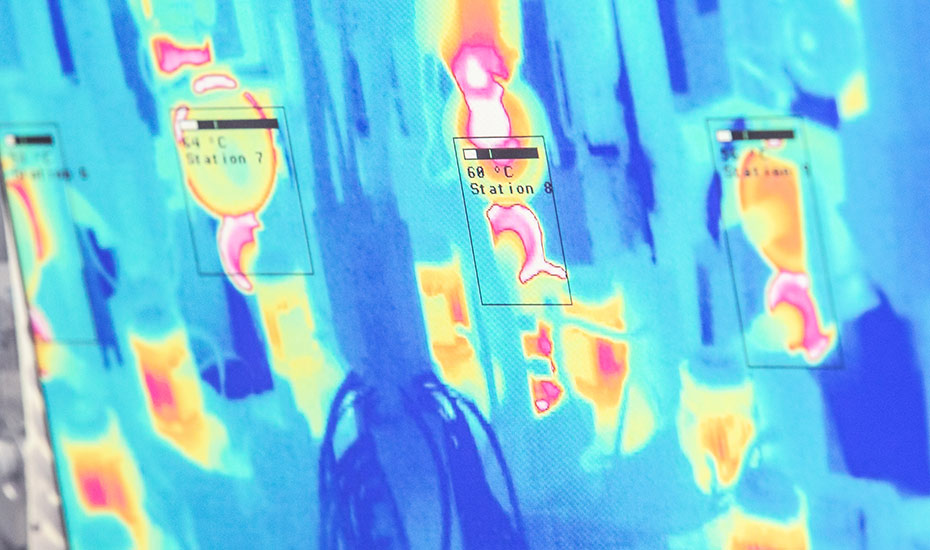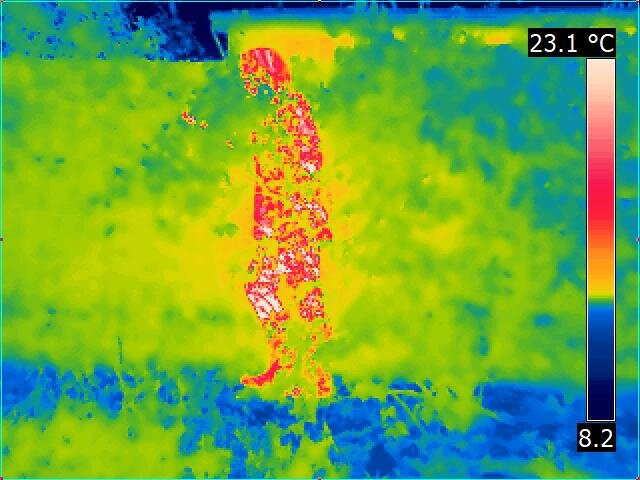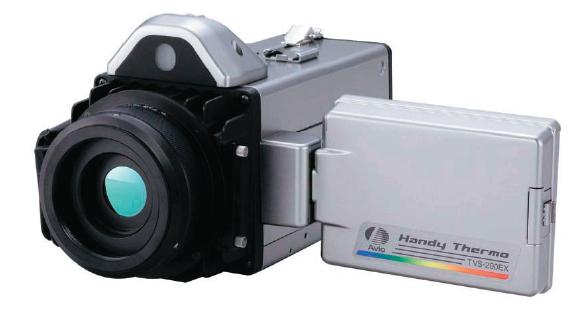What is the working principle of thermal imaging cameras? To accomplish this it is necessary for the camera to be equipped with a lens that allows IR frequencies to pass through before focusing on a specific sensor array, which will be able to detect and read them. Each of the pixels of the sensor array reacts to the wavelengths of infrared that strike it and converts the signals into electronic ones. These signals are transmitted through the main body an electronic processor. The processor converts them using algorithms into a colourmap that corresponds to various temperature values. This map is sent to the monitor that displays it to render. Many thermal imaging cameras also have a standard shooting mode. It works with the visible light spectrums just as any other point and click digital camera. This allows rapid comparison of two identical photos that are taken in IR and one shot in normal mode – which can be used to identify trouble spots quickly after the camera user has left the lens. Check out this thermal imaging camera. Take a look at this awesome infrared camera url for more.
Thermal Imaging Camera Usage Questions
In addition to frequently asked questions regarding how thermal imaging cameras function generally, there are also several common questions regarding specific use scenarios and the efficacy of the technology in specific settings or in particular applications. In this article we'll look at a few of the most effective answers , and also the rationale to support them.

Why Thermal Image Cameras Function More Efficiently At Night?
The temperature of the surrounding environment is dark and light, however, making thermal imaging cameras more efficient during the night. Instead, since the temperature of the surrounding environment - and in particular the core temperature of non-heated environments and objects generally lower at night than during sunlight hours, thermal imaging cameras can display warmer regions with higher contrast. Even on cold days, the energy from the sun will slowly be taken up by roads and buildings. The temperature of these things rises as time passes, which means they are less easily distinguishable against other objects of warmer temperatures that are detected and highlighted by camera's sensors. Check out this great thermal imaging camera blog for more.
Thermal imaging cameras also display objects that are warm in contrast following several hours of darkness, compared to just after sunset. They will also be more efficient in the morning than the afternoon, even if it's all daylight. Can thermal cameras work through glass? It might surprise you to find out that thermal imaging cameras are not made to work through glass. A complete explanation of the technical reason for this is complex from a physics standpoint however the concept is quite simple. Glass allows visible light through and serves as a mirror for infrared wavelengths. This is the reason IR camera lenses are usually made from zinc selenide or germanium. If you pointed the thermal detector camera at windows, you'd see something other than a clear thermal rendering. Instead, it would show blurred images and maybe a slight reflection of yourself.

Camera For Thermal Imaging
It's not a strict and fast standard. Certain frequencies of infrared can pass through glass. Different kinds of glass will allow different degrees of infrared. For instance windshields for cars produce superior results than standard glass that is used for household use. The image will most likely be obscured by infrared reflections from the wrong side of the glass. These images may be overlaid with varying degree. In all likelihood the object that is being observed isn't very clear and has a low contrast. A thermal imaging camera is not recommended to view glass (or other reflective surfaces). Take a look at this cool night vision camera details for more.
Are Thermal Cameras Able To Be Used Under Water?
The thermal cameras are not designed to be used underwater. The reason is partly due to the issues with glass mentioned above. Water blocks a lot infrared wavelengths the same way that the opaque barrier blocks visible-light wavelengths. Infrared detectors can't see through water. They are not able to detect wavelengths that pass through water. Water presents a different challenge to IR cameras because of its thermal conductivity, as well as specific heat. Water is four times more heat capacity of air and requires four times as long to increase or decrease the temperature of a similar volume by one degree. That means objects lose energy (or gain it) much faster relative to water, and at shorter distances. Submerged objects are more difficult to photograph for thermal imaging purposes than objects in the air.

Do Thermal Imaging Cameras Capable Of Seeing Through Walls?
No, they can't discern things. Thermal imaging cameras measure temperatures at the surface of objects within their line of sight. A thermal imaging camera can detect heat radiating from solid surfaces or walls. Have a look at this top rated infrared camera advice for more.
The Camera For Thermal Imaging Is In Use . Thermal Imaging Camera In Use
A majority of buildings are designed to trap heat. Exterior thermographic imagery seldom reveals much about what's happening inside. There are some caveats to this. A IR camera is a good option for extreme heat radiation from behind brick walls (such an indoor fireplace) however, the walls themselves will rapidly become hot. Some thermal cameras can sense the heat emanating from those who are on opposite sides of small (and cold!) walls. They can be placed on the wall for a long time to permit their body heat to transfer across the wall's material.
Applications Of Thermal Imaging Cameras
Thermal detection cameras aren't only used for engineering purposes as well as for emergency response. The technology is used frequently in various scenarios such as police pursuits in nighttime, such as firefighting and disaster relief search and rescue. There are many other common uses of thermal imaging cameras which may not be evident. This section will briefly address some of the most well-known situations.
